Effect of Heat Treatment on Microstructure and Tensile Property of Ti-6Al-6V-2Sn Alloy
Abstract
1. Introduction
2. Materials and Methods
3. Results
3.1. Qualitative Analysis of Phases
3.2. Microstructure
3.3. Tensile Properties
3.4. Fracture Morphology
4. Discussion
4.1. Effect of Solution Temperature for the As-Quenched Conditions
4.2. Effect of Heat-Treatment Temperature for the Aged Conditions
5. Conclusions
- (1)
- When the alloy is solution-treated at 970 °C and water-quenched, hexagonal α′ and orthorhombic α″ martensite phases form. The size of α″ is obviously smaller than α′. When the alloy is solution-treated at 920 °C and water-quenched, α′ phase does not form and only α″ forms.
- (2)
- With the increase of solution temperature, the strength of the alloy increases and the ductility decreases due to the decrease of the volume fraction of equiaxial αp phase and the increase of the volume fraction of acicular αs phase formed during aging. When the solution temperature is 920 °C, the strength and ductility of the alloy aged at 540 °C are relatively balanced with a yield strength of 1407 MPa, ultimate tensile strength of 1489 MPa, reduction of area of 32.5%, and elongation of 9%.
- (3)
- With the increase of aging temperature, the strength of the alloy deteriorates and the ductility enhances, which may be due to the coarsening of αs and its higher fraction. The mechanical properties of the alloy are optimal when the aging temperature is 520 °C with a yield strength of 1437 MPa, ultimate tensile strength of 1509 MPa, reduction of area of 29%, and elongation of 10.5%.
Author Contributions
Funding
Institutional Review Board Statement
Informed Consent Statement
Data Availability Statement
Conflicts of Interest
References
- Wood, J.R.; Russo, P.A.; Welter, M.F. Thermomechanical Processing and Heat Treatment of Ti-6Al-2Sn-2Zr-2Cr-2Mo-Si for Structural Applications. Mater. Sci. Eng. A Struct. Mater. Prop. Microstruct. Process. 1998, 243, 109–118. [Google Scholar] [CrossRef]
- Banerjee, D.; Williams, J. Perspectives on Titanium Science and Technology. Acta Mater. 2013, 61, 844–879. [Google Scholar] [CrossRef]
- Wollmann, M.; Kiese, J.; Wagner, L. Properties and Applications of Titanium Alloys in Transport. Ti-2011. In Proceedings of the 12th World Conference on Titanium, Beijing, China, 19–24 June 2011; pp. 837–844. [Google Scholar]
- Leyens, C.; Peters, M. Titanium and Titanium Alloys. Belov, J.C.W.F., Ed.; Chemical and Chemical Industry Press: Beijing, China, 2005; pp. 292–302. [Google Scholar]
- Fujii, H. Strengthening of Alpha+Beta Titanium Alloys by Thermomechanical Processing. Mater. Sci. Eng. A Struct. Mater. Prop. Microstruct. Process. 1998, 243, 103–108. [Google Scholar] [CrossRef]
- Boyer, R.; Welsch, G. Materials Properties Handbook: Titanium Alloys; ASM International: Materials Park, OH, USA, 1994; pp. 637–666. [Google Scholar]
- Sarma, J.; Kumar, R.; Sahoo, A.K.; Panda, A. Enhancement of material properties of titanium alloys through heat treatment process: A brief review. Mater. Today Proc. 2020, 23, 561–564. [Google Scholar] [CrossRef]
- Filip, R.; Kubiak, K.; Ziaja, W.; Sieniawski, J. The effect of microstructure on the mechanical properties of two-phase titanium alloys. J. Mater. Process. Technol. 2003, 133, 84–89. [Google Scholar] [CrossRef]
- Ortiz, M. Investigation of Thermal-Related Effects in Hot SPIF of Ti-6Al-4V Alloy. Int. J. Precis. Eng. Manuf. Green Technol. 2020, 7, 299–317. [Google Scholar] [CrossRef]
- Barriobero-Vila, P.; Oliveira, V.B.; Schwarz, S. Tracking the Alpha Martensite Decomposition during Continuous Heating of a Ti-6A1-6V-2Sn Alloy. Acta Mater. 2017, 135, 132–143. [Google Scholar] [CrossRef]
- Barriobero-Vila, P.; Williams, J.C. Role of Element Partitioning on the alpha-beta Phase Transformation Kinetics of a Bi-modal Ti-6Al-6V-2Sn Alloy during Continuous Heating. J. Alloys Compd. 2015, 626, 330–339. [Google Scholar] [CrossRef]
- Huang, R.T.; Huang, W.L.; Huang, R.H. Effects of Microstructures on the Notch Tensile Fracture Feature of Heat-treated Ti-6Al-6V-2Sn Alloy. Mater. Sci. Eng. A Struct. Mater. Prop. Microstruct. Process. 2014, 595, 297–305. [Google Scholar] [CrossRef]
- Bolisowa, E.A. Metallography of Titanium Alloys; National Defense Industry Press: Beijing, China, 1980; p. 20. [Google Scholar]
- Shao, J.J.C.S.Z. In-situ Observation of Transgranular Growth of Martensite in A Cu-Zn-Al Shape Memory Alloy. Acta Met. Sin. 1988, 24, 213–216. [Google Scholar]
- Li, C.; Li, G.; Yang, Y.; Yang, K. Influence of Quenching Tempetrature on Martensite Type in Ti-4Al-4.5Mo Alloy. Acta Met. Sin. 2010, 46, 1061–1065. [Google Scholar] [CrossRef]
- Zhu, B.; Zeng, W.D.; Chen, L. Influences of Solution and Aging Treatment Process on Microstructure and Mechanical Properties of Ti-6Al-6V-2Sn Titanium Alloy Rods. Chin. J. Nonferrous Met. 2018, 28, 677–684. [Google Scholar] [CrossRef]
- Li, C.; Chen, J.H.; Wu, X. A Comparative Study of the Microstructure and Mechanical Properties of alpha plus beta Titanium Alloys. Met. Sci. Heat Treat. 2014, 56, 374–380. [Google Scholar] [CrossRef]
- Lei, X.; Dong, L.; Zhang, Z.; Liu, Y.; Hao, Y.; Yang, R.; Zhang, L.-C. Microstructure, Texture Evolution and Mechanical Properties of VT3-1 Titanium Alloy Processed by Multi-Pass Drawing and Subsequent Isothermal Annealing. Metals 2017, 7, 131. [Google Scholar] [CrossRef]
- Yang, R.; Saunders, N.; Leake, J.A. Euilibria and Microstructural Evolution in the Beta/Beta ‘Gamma’ Region of the Ni-Al-Ti System- Modeling and Experiment. Acta Metall. Mater. 1992, 40, 1553–1562. [Google Scholar] [CrossRef]
- Ahmed, T.; Rack, H.J. Martensitic transformations in Ti-(16–26 at%) Nb alloys. J. Mater. Sci. 1996, 31, 4267–4276. [Google Scholar] [CrossRef]
- Elmer, J.W.; Palmer, T.A.; Babu, S.S. Phase Transformation Dynamics during Welding of Ti-6Al-4V. J. Appl. Phys. 2004, 95, 8327–8339. [Google Scholar] [CrossRef]
- Galarraga, H.; Warren, R.J.; Lados, D.A.; Dehoff, R.R.; Kirka, M.M.; Nandwana, P. Effects of heat treatments on microstructure and properties of Ti-6Al-4V ELI alloy fabricated by electron beam melting (EBM). Mater. Sci. Eng. A 2017, 685, 417–428. [Google Scholar] [CrossRef]
- Motyka, M. Decomposition of Deformed Alpha ’(Alpha’) Martensitic Phase in Ti-6Al-4V Alloy. Mater. Sci. Technol. 2019, 35, 260–272. [Google Scholar] [CrossRef]
- Zhu, Z.; Wang, Q.J.; Mo, W. Metallography and Heat Treatment of Titanium; Metallurgical Industry Press: BeiJing, China, 2014; p. 50. [Google Scholar]
- Bolisowa, E.A. Metallography of Titanium Alloys; National Defense Industry Press: Beijing, China, 1980; pp. 191–194. [Google Scholar]
- Chen, J.; Zhao, Y.Q.; Zeng, W.D. Influence of Primary alpha Phase on Impact Toughness of TC21 Titanium Alloy. Rare Met. Mater. Eng. 2006, 35, 174–177. [Google Scholar]
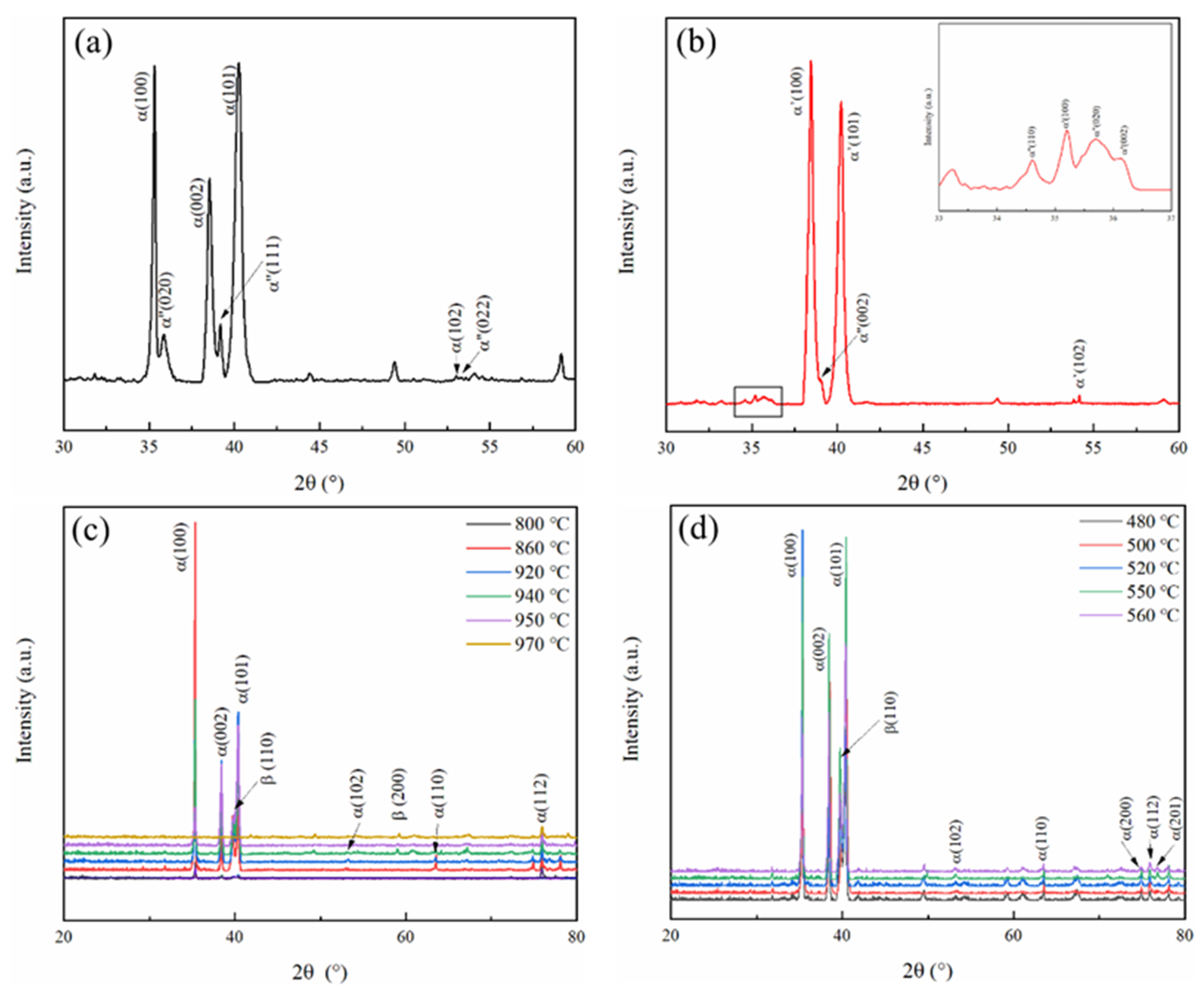

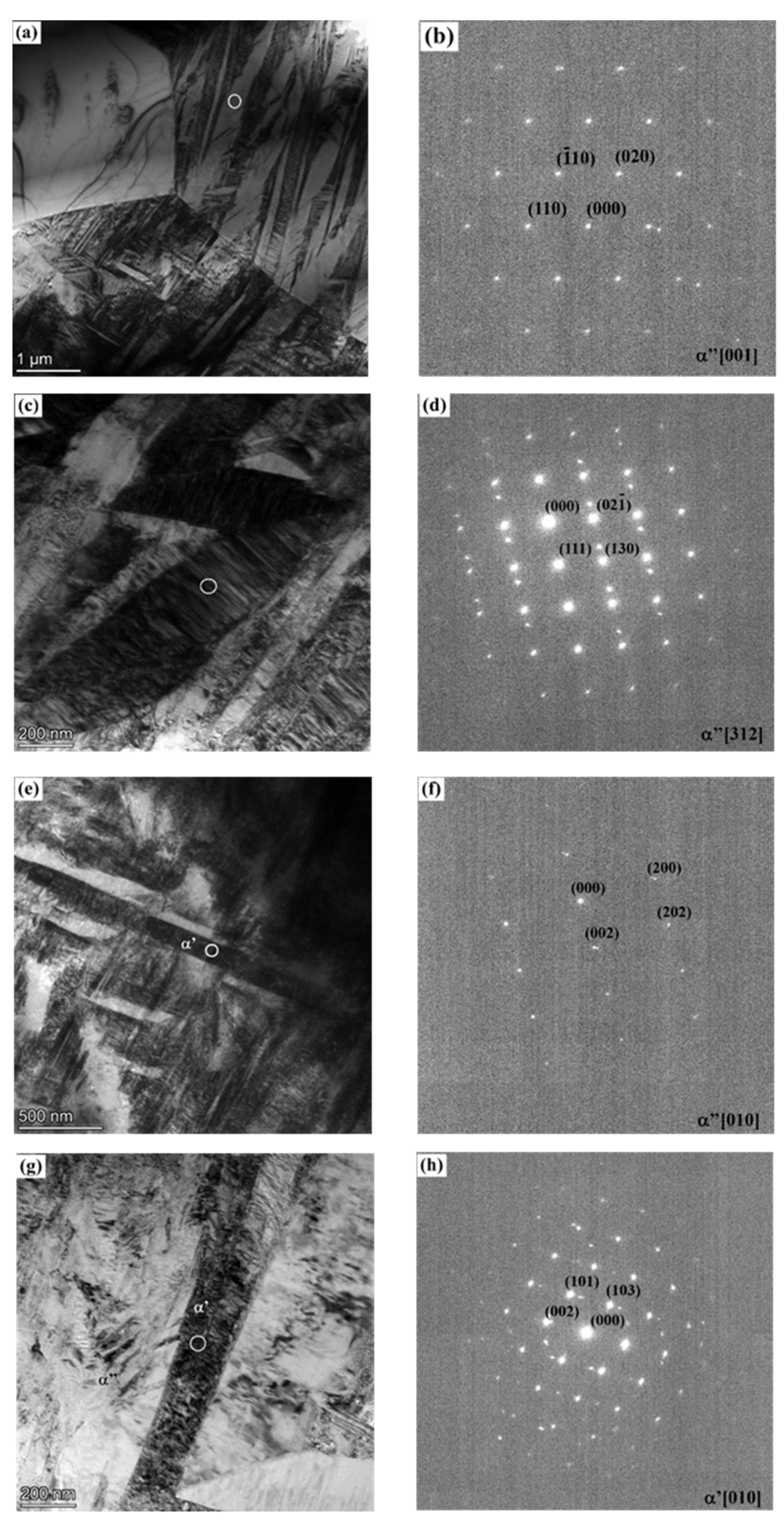
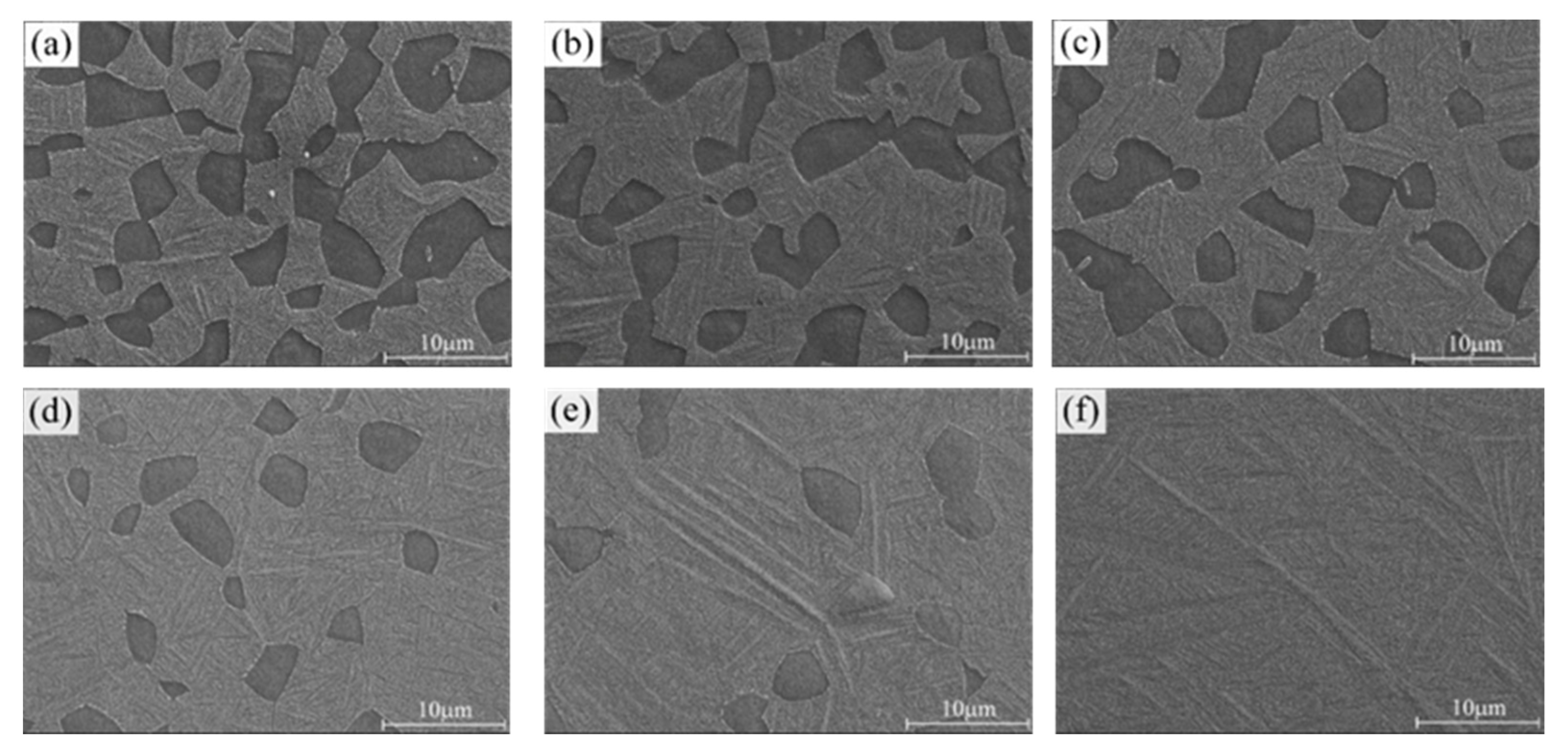


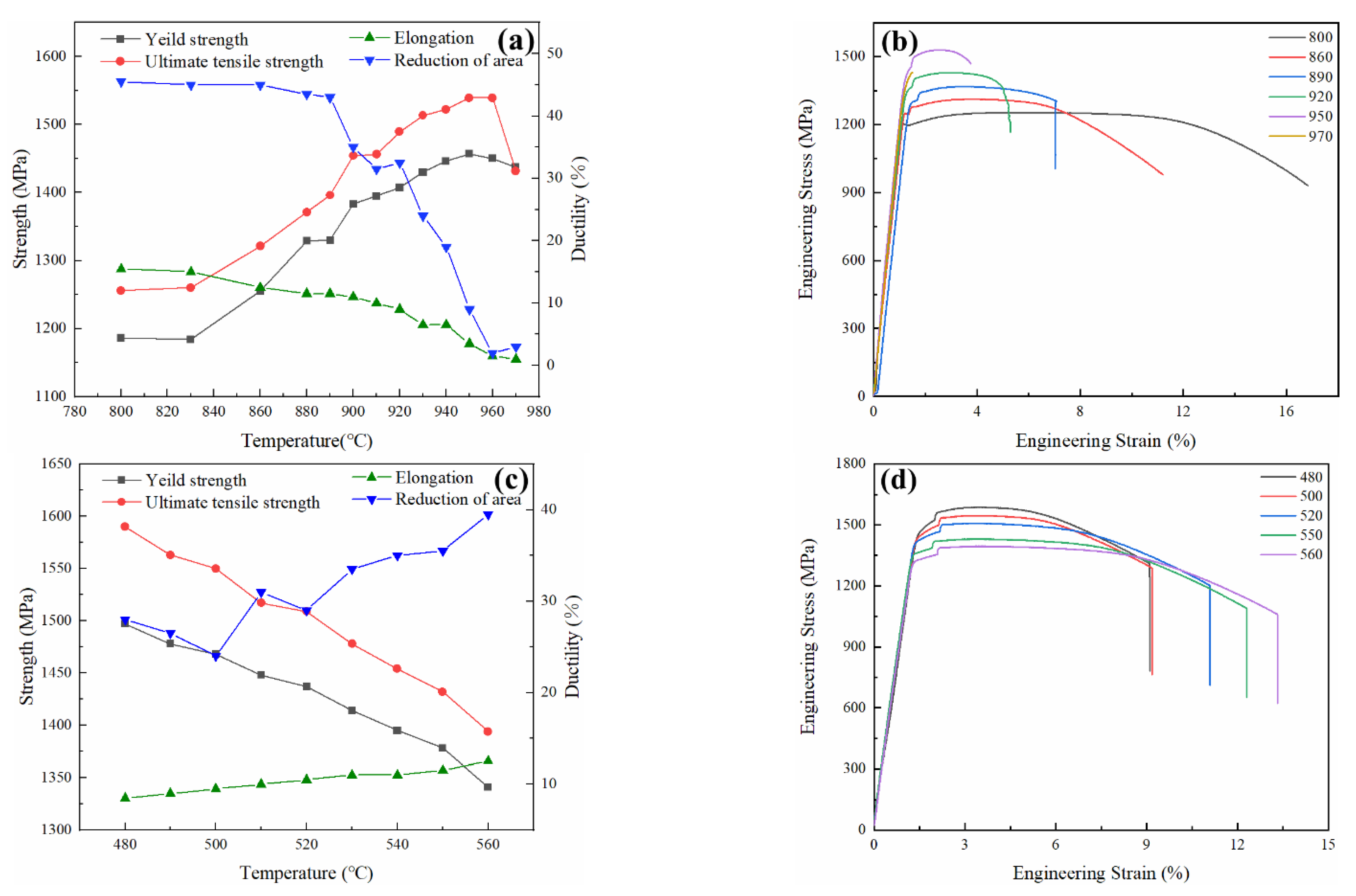
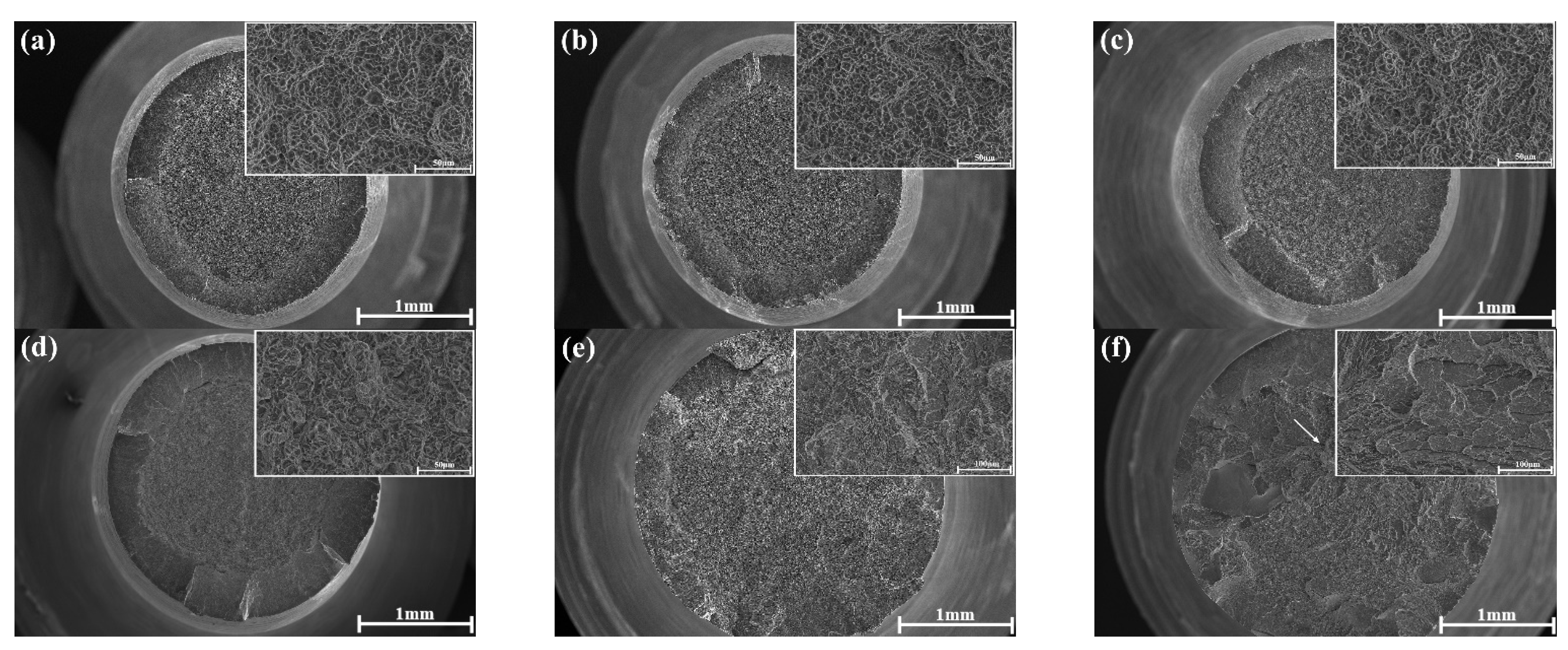
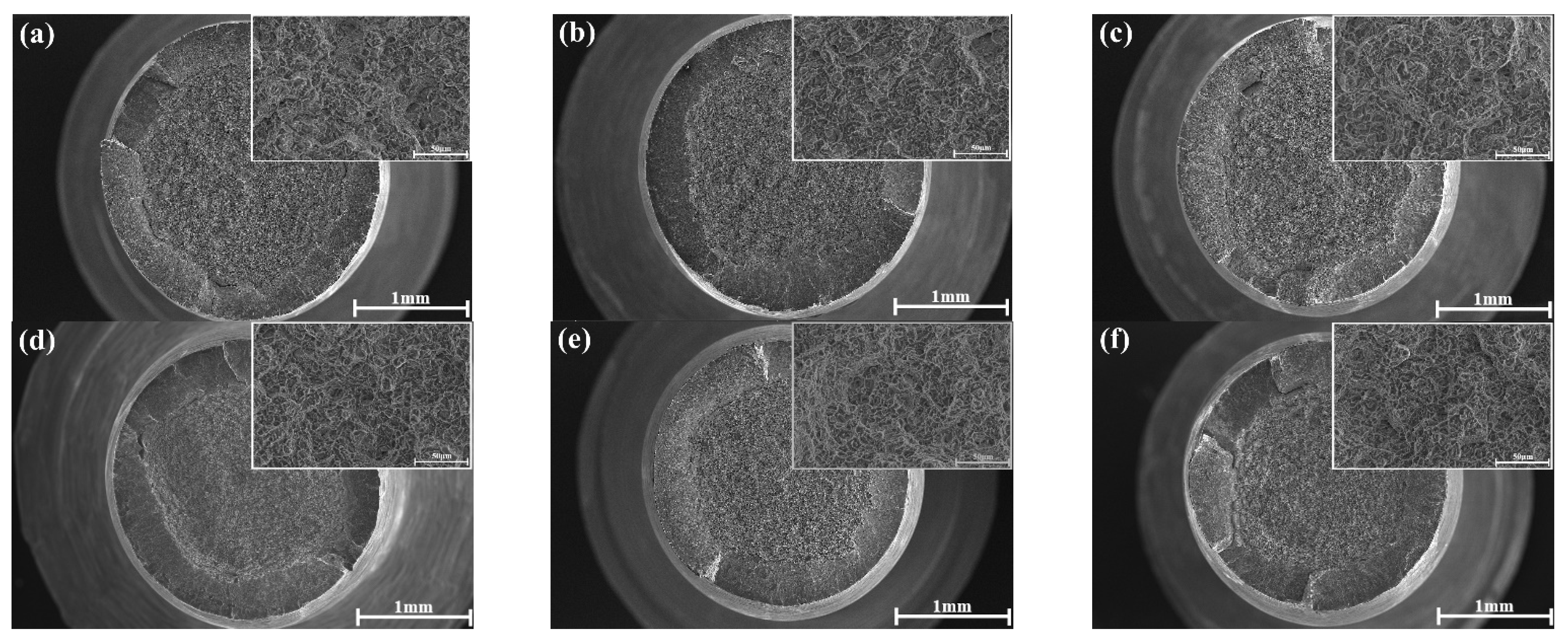
| Element | Al | V | Sn | Cu | Fe | C | O% (m/m) | N% (m/m) | Ti |
|---|---|---|---|---|---|---|---|---|---|
| Content (%) | 5.6 | 5.5 | 2.02 | 0.46 | 0.54 | 0.022 | 0.155 | 0.090 | Bal. |
| Group | Specimen Code | Heat Treatment |
|---|---|---|
| 1 | SA | 920 °C × 1 h, WQ |
| SB | 970 °C × 1 h, WQ | |
| 2 | 800 | 800 °C × 1 h, WQ + 540 °C × 4 h, AC |
| 860 | 860 °C × 1 h, WQ + 540 °C × 4 h, AC | |
| 890 | 890 °C × 1 h, WQ + 540 °C × 4 h, AC | |
| 920 | 920 °C × 1 h, WQ + 540 °C × 4 h, AC | |
| 950 | 950 °C × 1 h, WQ + 540 °C × 4 h, AC | |
| 970 | 970 °C × 1 h, WQ + 540 °C × 4 h, AC | |
| 3 | 480 | 900 °C × 1 h, WQ + 480 °C × 4 h, AC |
| 500 | 900 °C × 1 h, WQ + 500 °C × 4 h, AC | |
| 520 | 900 °C × 1 h, WQ + 520 °C × 4 h, AC | |
| 540 | 900 °C × 1 h, WQ + 540 °C × 4 h, AC | |
| 550 | 900 °C × 1 h, WQ + 550 °C × 4 h, AC | |
| 560 | 900 °C × 1 h, WQ + 560 °C × 4 h, AC |
Publisher’s Note: MDPI stays neutral with regard to jurisdictional claims in published maps and institutional affiliations. |
© 2021 by the authors. Licensee MDPI, Basel, Switzerland. This article is an open access article distributed under the terms and conditions of the Creative Commons Attribution (CC BY) license (http://creativecommons.org/licenses/by/4.0/).
Share and Cite
Wang, Q.; Lei, X.; Hu, M.; Xu, X.; Yang, R.; Dong, L. Effect of Heat Treatment on Microstructure and Tensile Property of Ti-6Al-6V-2Sn Alloy. Metals 2021, 11, 556. https://doi.org/10.3390/met11040556
Wang Q, Lei X, Hu M, Xu X, Yang R, Dong L. Effect of Heat Treatment on Microstructure and Tensile Property of Ti-6Al-6V-2Sn Alloy. Metals. 2021; 11(4):556. https://doi.org/10.3390/met11040556
Chicago/Turabian StyleWang, Qirui, Xiaofei Lei, Ming Hu, Xin Xu, Rui Yang, and Limin Dong. 2021. "Effect of Heat Treatment on Microstructure and Tensile Property of Ti-6Al-6V-2Sn Alloy" Metals 11, no. 4: 556. https://doi.org/10.3390/met11040556
APA StyleWang, Q., Lei, X., Hu, M., Xu, X., Yang, R., & Dong, L. (2021). Effect of Heat Treatment on Microstructure and Tensile Property of Ti-6Al-6V-2Sn Alloy. Metals, 11(4), 556. https://doi.org/10.3390/met11040556







